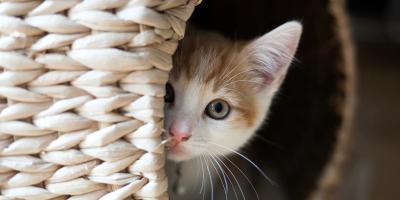
Learning how to clean a cat's ears is not that difficult. It takes just a few supplies, a little forethought, and a heaping helping of patience.
You likely already know that cats are sticklers when it comes to staying clean, grooming themselves repeatedly each day for what seems like hours. As fastidious as they are, though, cats sometimes need a wee bit of help to clean parts of their bodies that are difficult or impossible for them to reach with their tongues, such as their ears.
As a pet parent, it’s important that you keep a watchful eye on your cat’s ears and clean them whenever needed. Doing so can help your cat avoid painful ear infections and other issues.
When Should You Clean a Cat’s Ears?
It's vital that you check the interior of your cat’s ears regularly to look for signs of infection. If you have a regular grooming routine for your feline, you can make ear examination a part of that. It's best to check out your cat’s ears at least weekly, but you can certainly give them a look-see more often if you suspect there’s a problem brewing.
Your cat’s individual habits can be a guide to how often the cat’s ears need to be cleaned. Cats who live indoors and who are rarely outdoors may need their ears cleaned only on rare occasions. Check your cat's ears more often if they spend a lot of time in nature, as they'll tend to pick up a little more dirt and grime each day.
How to Clean a Kitten’s Ears
Begin checking your cat’s ears regularly when they are a kitten and clean them the same way you would clean an adult cat’s ears. Starting during kittenhood is best because it helps the cat become accustomed to having you touch and handle their ears. Starting early means that your kitty will be less nervous about the whole process, making it easier for both of you.
Signs of Problems to Look for During Ear Cleaning
Signs of ear infection are the main thing to be aware of when cleaning your cat’s ears. Be watchful for signs of feline ear infection, including:
- Foul odours
- Scaly skin
- Bald patches on skin
- Scratching of the ears
- Excessive shaking of the head
- Excess ear wax accumulation
- Dark-coloured matter around cat’s ears
- Ears that are tender when touched
These symptoms can be strong indicators of infection or other problems. Whenever they're present, have your feline evaluated by your vet as soon as possible.
Preparing to Clean a Cat’s Ears
It's best to initiate a cleaning attempt only when your cat is relaxed. A good time for this is right after you’ve been grooming the cat or even while the cat is napping on the sofa.
Once your cat is calm and relaxed, turn the cat’s ear inside out. This lets you visually access the ear canal. You can also shine a small flashlight into the canal so that you can more readily see any problems such as built-up earwax that can indicate an ear infection. Discharge and odd, foul-smelling odours are additional indicators that your cat’s ears are infected.
Your cat’s ears are healthy if they are a pale pink colour and do not have visible dirt or earwax buildup. This indicates that there is no need for ear cleaning.
If you do see dirt or excess wax inside the cat’s ears, giving them a good clean can help prevent problems. Most vet offices and pet stores sell cat ear cleaner. Apply the cat ear cleaner according to the package instructions, which usually involves using a warm cotton ball for application. Carefully remove the dirt or wax with the cotton ball.
Best Tips for Cleaning a Cat’s Ears
Avoid using ear cleaning products that are not made specifically for cats, particularly products containing alcohol, which can result in irritation of your cat’s sensitive ears. In addition, avoid allowing liquids to make their way down your cat’s ear canals when cleaning; doing so can cause infection and other issues.
If you're working with a cat who is unaccustomed to having humans handle their ears, it may make things easier to ask a friend to hold the cat while you do the deed. If you have no available help, wrap the cat in a towel to reduce its stress and keep it from scratching or biting you as you work. If you want a hands-on look at how to clean a cat's ears, you can always entrust your vet with the task.
Once your cat’s ears are cleaned, think about giving your kitty a treat. This allows the cat to associate ear cleaning with something positive — and hopefully, that'll help things go more smoothly on each subsequent cleaning.
Related articles



